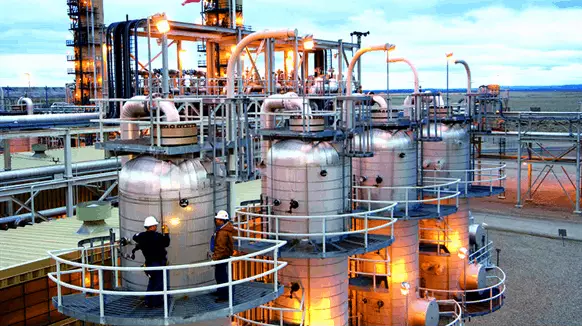Exxon's Wyoming CCS Project Expansion Restarts After 2-Year Delay

ExxonMobil has initiated the process for engineering, procurement, and construction contracts as part of its plans to expand carbon capture and storage (CCS) at the LaBarge facility in Wyoming.
The facility has already captured more CO2 than any other facility in the world. The expansion project will capture up to 1 million metric tons of CO2, in addition to the 6-7 million metric tons already captured at LaBarge each year.
“The expansion of our carbon capture and storage operations at LaBarge underscores our commitment to advancing CCS projects around the world,” said Joe Blommaert, president of ExxonMobil Low Carbon Solutions. “This technology is critical to help meet society’s lower-emissions goals, and with the right policies in place, is immediately deployable. ExxonMobil has long supported policies that provide a predictable price on carbon emissions, which enable new or expanded carbon capture and storage investments.”
The LaBarge expansion project is in the design and permitting phase and a request for bids for engineering, procurement, and construction contracts has been issued to third parties. A final investment decision is expected in 2022 and will be based on several factors, including regulatory approvals. Operations could start as early as 2025.
It is worth noting that this is two years later than what was previously proposed. Exxon previously planned to start construction in the summer of 2020 but decided against it due to Covid-19 and plummeting oil prices.
The proposed $400 million investment is the latest in multiple expansions of carbon capture at LaBarge. The location currently represents nearly 20 percent of all CO2 captured in the world each year. The expansion will further mitigate emissions by capturing up to an additional 1 million metric tons of CO2 each year.
ExxonMobil’s Low Carbon Solutions arm is evaluating several other large-scale carbon capture and storage projects in the US Gulf Coast, Europe, and Asia. The company has an equity share in approximately one-fifth of global CO2 capture capacity and has captured around 40 percent of all the captured anthropogenic CO2 in the world.
In addition to producing natural gas, LaBarge is one of the world’s largest sources of helium and produces around 20 percent of the global supply. Helium is a critical component in many fields, including scientific research, magnetic resonance imaging, high-tech manufacturing, space exploration, and national defense.
ExxonMobil reminded that the International Energy Agency projected that CCS could mitigate up to 15 percent of global emissions by 2040 and that the U.N. Intergovernmental Panel on Climate Change estimated that global decarbonization efforts could be twice as costly without wide-scale deployment of carbon capture and storage.
To contact the author, email bojan.lepic@rigzone.com
What do you think? We’d love to hear from you, join the conversation on the Rigzone Energy Network.
The Rigzone Energy Network is a new social experience created for you and all energy professionals to Speak Up about our industry, share knowledge, connect with peers and industry insiders and engage in a professional community that will empower your career in energy.
- Regulator Lays Charges Over Huge Oil Spill Off Canada
- Shell Starts Production From Arran Gas Field
- Oil Drops After 7-Year High As Stockpiles Surprisingly Fall
- All CCS Clusters Needed For UK To Reach Net-Zero By 2050, OGUK Says
- Renewables Giants Nixed From Clean Energy Index
- Oil Eases On Renewed Demand Concerns
- Neptune Energy Endorses Eliminating Gas Flaring By 2030
- Oil-Data Startup To Figure Out Untapped Reserves Worth
- Oil Refiners Under Threat From Natural Gas Crisis
- DOE Provides $20MM Funding for Regional CCUS Projects
- Saudis Launch First Offshore Oil Platform Inspired Tourism Project
- Top Headlines: Energy Crisis Threatens to Hit USA Grids and More
- Shell Announces New Directors
- Guyana Looking To Build 135-Mile Subsea Gas Pipeline
- Talos, TechnipFMC To Develop CCS Projects Along US GOM Coast
- Louisiana Announces $4.5B Clean Energy Complex
- Energy Crisis Prompts Asia to Turn to USA for Oil
- Valaris Drillship Coming Out Of Lay-Up For Petrobras
- Lukoil, Gazprom Neft Team Up On Oil Recovery Projects
- Aker BP Set To Drill Lyderhorn East Offshore Well
- Hurricane Sam Could Make USA Landfall This Week
- Top Headlines: Hurricane Sam Could Make USA Landfall This Week and More
- Energy Crisis Threatens to Hit USA Grids
- Analysts Release Latest Oil Price Forecasts
- First Fully Automated Land Rig Drills First Well
- Permian Shale Oil Is Booming Again
- Saudis Launch First Offshore Oil Platform Inspired Tourism Project
- USA EIA Bumps Up Oil Price Forecast
- Shell Sheds Egypt Onshore Assets Days After Permian Exit
- 3Q Oil and Gas Discovery Roundup


